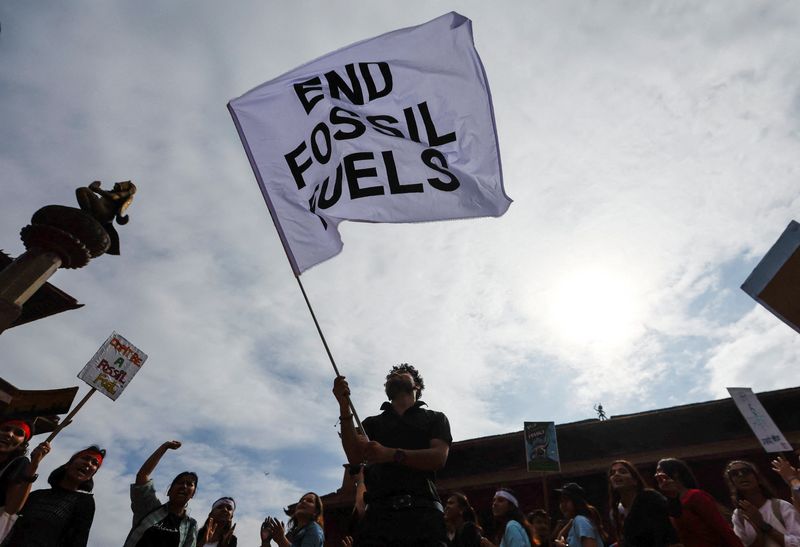By Sarah McFarlane
(Reuters) – World governments agreed at the COP26 climate summit in Glasgow two years ago to phase out “inefficient” fossil fuel subsidies to help fight global warming.
Since then, however, global fossil fuel subsidies have risen $2 trillion to $7 trillion, according to the International Monetary Fund, as governments around the world moved to protect consumers from rising energy prices.
At this year’s climate gathering in Dubai, EU countries will be looking to harden the COP26 deal to phase out the subsidies by pushing for a deadline of 2030 to get it done, but it is unclear how much support the proposal will gain.
EU governments were among those that have increased support for fossil fuels since Glasgow, mainly as a response to energy security concerns following Russia’s invasion of Ukraine.
Here are some examples of how fossil fuels are subsidised around the world.
CHINA
China’s total fossil fuel subsidies were the highest in the world at $2.2 trillion in 2022, amounting to 12.5% of the country’s total GDP, according to the IMF.
The bulk of the subsidies are “implicit”, a category which includes undercharging for environmental costs or forgoing tax revenues, the IMF said.
Support offered to coal-fired power plants includes direct funding, preferential loans, and power purchase guarantees.
China also unveiled a new scheme earlier this month that pays coal-fired power plants not for the electricity they supply, but for making capacity ready and available to the grid when needed – a measure also used by grid operators in the U.S. to keep such plants from retiring.
A 2020 study by professors at Nanjing Audit University said China’s coal subsidy policies effectively reduced China’s coal prices by 4.2% and drove up output by 7.6%.
China also regularly intervenes to keep consumer power and fuel prices low. For example, it subsidises its refiners when global oil prices rise above $130 a barrel so they can keep fuel prices affordable.
UNITED STATES
U.S. fossil fuel subsidies stretch across the U.S. tax code, which makes detailing their costs complex. The IMF estimates they stood at $760 billion in 2022, a figure topped only by China.
One U.S. tax break called intangible drilling costs allows producers to deduct a majority of their costs from drilling new oil wells. The Joint Committee on Taxation, a nonpartisan panel of Congress, has estimated that eliminating it could generate $13 billion over a decade.
Another, the percentage depletion tax break which allows independent producers to recover development costs of declining oil gas and coal reserves, could generate about $12.9 billion in revenue over 10 years, it has said.
President Joe Biden, a Democrat, has proposed axing fossil fuel subsidies in his annual budget, largely a political document used in negotiations with Congress.
But his efforts have gone nowhere amid only a thin Democratic majority in the Senate and as Republicans control the House of Representatives.
RUSSIA
The world’s top seaborne exporter of diesel and third largest producer of oil spent $420 billion on fossil fuel subsidies last year, according to the IMF.
These include payments to oil refineries to compensate them for selling fuel on the domestic market instead of exporting it for a higher prices.
Russia’s coal industry is supported by measures including preferential rail tariffs, direct budgetary transfers for coal exploration, and tax relief on some coal mining, according to think-tank ODI.
INDIA
Fossil fuel subsidies in India totaled $350 billion last year, according to the IMF. Coal dominates India’s electricity production and the country is one of the world’s top producers.
Coal subsidies include exemption of customs duty on coal mining equipment, reduced haulage rates for long-distance rail, and low-interest loans for coal power plants, according to the International Institute for Sustainable Development.
EU
European governments more than doubled fossil fuel subsidies to $310 billion in 2022 in response to the energy crisis, IMF data showed.
At least 230 temporary subsidy measures were taken by governments across the EU last year, according to a European Commission report, after Russia cut gas supplies to the region.
This reversed the trend in place since 2018 of shrinking support.
Most European governments plan to reduce their reliance on fossil fuels, with the clearest commitments in coal power and fossil fuel-based heating in buildings.
MIDDLE EAST
Oil and gas producers in the Middle East including Qatar and Saudi Arabia had some of the highest fossil fuel subsidies per person, IMF data showed.
Historically, governments in the region have kept energy prices artificially low, in part to redistribute resource wealth among their populations.
Qatar provides free electricity to its citizens, for instance.
CANADA
Earlier this year Canada unveiled plans for eliminating inefficient fossil fuel subsidies.
Oil and gas projects could still receive support, however, if projects included plans for emissions reduction technologies such as carbon capture, and environmental groups criticized the plan for lacking details and leaving open certain loopholes.
(Reporting by Sarah McFarlane, Timothy Gardner and David Stanway; Editing by Jan Harvey)
